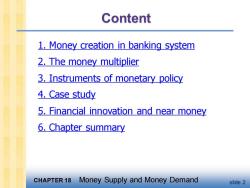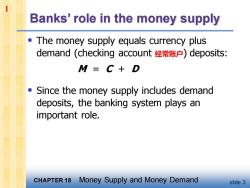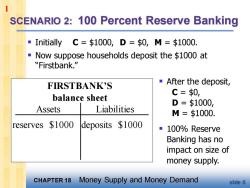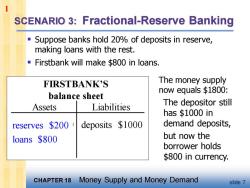《西方经济学》课程PPT教学课件(宏观经济学)Chapter 18 Money supply and monetary Policy

CHAPTER EIGHTEEN Money Supply and Monetary Policy macroeconomics N.Gregory Mankiw College of Management,HUST
macroeconomics N. Gregory Mankiw macro College of Management, HUST CHAPTER EIGHTEEN Money Supply and Monetary Policy

Chapter objectives ■Money supply how the banking system "creates"money three ways the Fed can control the money supply why the Fed can't control it precisely Theories of money demand a portfolio theory -a transactions theory:the Baumol-Tobin model CHAPTER 18 Money Supply and Money Demand slide 1
CHAPTER 18 Money Supply and Money Demand slide 1 Chapter objectives ▪ Money supply – how the banking system “creates” money – three ways the Fed can control the money supply – why the Fed can’t control it precisely ▪ Theories of money demand – a portfolio theory – a transactions theory: the Baumol-Tobin model

Content 1.Money creation in banking system 2.The money multiplier 3.Instruments of monetary policy 4.Case study 5.Financial innovation and near money 6.Chapter summary CHAPTER 18 Money Supply and Money Demand slide 2
CHAPTER 18 Money Supply and Money Demand slide 2 Content 1. Money creation in banking system 2. The money multiplier 3. Instruments of monetary policy 4. Case study 5. Financial innovation and near money 6. Chapter summary

1 Banks'role in the money supply ■ The money supply equals currency plus demand(checking account经常账户)deposits: M=C+D Since the money supply includes demand deposits,the banking system plays an important role. CHAPTER 18 Money Supply and Money Demand slide 3
CHAPTER 18 Money Supply and Money Demand slide 3 Banks’ role in the money supply ▪ The money supply equals currency plus demand (checking account 经常账户) deposits: M = C + D ▪ Since the money supply includes demand deposits, the banking system plays an important role. 1

1 A few preliminaries Reserves (R):the portion of deposits that banks have not lent. To a bank,liabilities include deposits, assets include reserves and outstanding loans 100-percent-reserve banking:a system in which banks hold all deposits as reserves. Fractional-reserve banking: a system in which banks hold a fraction of their deposits as reserves. CHAPTER 18 Money Supply and Money Demand slide 4
CHAPTER 18 Money Supply and Money Demand slide 4 A few preliminaries ▪ Reserves (R ): the portion of deposits that banks have not lent. ▪ To a bank, liabilities include deposits, assets include reserves and outstanding loans ▪ 100-percent-reserve banking: a system in which banks hold all deposits as reserves. ▪ Fractional-reserve banking: a system in which banks hold a fraction of their deposits as reserves. 1

SCENARIO 1:No Banks With no banks, D=0andM=C=$1000. CHAPTER 18 Money Supply and Money Demand slide 5
CHAPTER 18 Money Supply and Money Demand slide 5 SCENARIO 1: No Banks With no banks, D = 0 and M = C = $1000. 1

SCENARIO 2:100 Percent Reserve Banking ·Initially C=$1000,D=$0,M=$1000. Now suppose households deposit the $1000 at "Firstbank." FIRSTBANK'S After the deposit, balance sheet C=$0, D=$1000, Assets Liabilities M=$1000. reserves $1000 deposits $1000 ■100%Reserve Banking has no impact on size of money supply. CHAPTER 18 Money Supply and Money Demand slide 6
CHAPTER 18 Money Supply and Money Demand slide 6 SCENARIO 2: 100 Percent Reserve Banking ▪ After the deposit, C = $0, D = $1000, M = $1000. ▪ 100% Reserve Banking has no impact on size of money supply. FIRSTBANK’S balance sheet Assets Liabilities reserves $1000 deposits $1000 ▪ Initially C = $1000, D = $0, M = $1000. ▪ Now suppose households deposit the $1000 at “Firstbank.” 1

SCENARIO 3:Fractional-Reserve Banking Suppose banks hold 20%of deposits in reserve, making loans with the rest. Firstbank will make $800 in loans. FIRSTBANK'S The money supply now equals $1800: balance sheet Assets Liabilities The depositor still has $1000 in reserves $200 deposits $1000 demand deposits, loans $800 but now the borrower holds $800 in currency. CHAPTER 18 Money Supply and Money Demand slide 7
CHAPTER 18 Money Supply and Money Demand slide 7 SCENARIO 3: Fractional-Reserve Banking The money supply now equals $1800: The depositor still has $1000 in demand deposits, but now the borrower holds $800 in currency. FIRSTBANK’S balance sheet Assets Liabilities deposits $1000 ▪ Suppose banks hold 20% of deposits in reserve, making loans with the rest. ▪ Firstbank will make $800 in loans. reserves $1000 reserves $200 loans $800 1

SCENARIO 3:Fractional-Reserve Banking Thus,in a fractional-reserve banking system,banks create money. The money supply FIRSTBANK'S now equals $1800: balance sheet The depositor still Assets Liabilities has $1000 in reserves $200 deposits $1000 demand deposits, loans $800 but now the borrower holds $800 in currency. CHAPTER 18 Money Supply and Money Demand slide 8
CHAPTER 18 Money Supply and Money Demand slide 8 SCENARIO 3: Fractional-Reserve Banking The money supply now equals $1800: The depositor still has $1000 in demand deposits, but now the borrower holds $800 in currency. FIRSTBANK’S balance sheet Assets Liabilities reserves $200 loans $800 deposits $1000 Thus, in a fractional-reserve banking system, banks create money. 1

1 SCENARIO 3:Fractional-Reserve Banking ■ Suppose the borrower deposits the $800 in Secondbank. Initially,Secondbank's balance sheet is: SECONDBANK'S ■But then balance sheet Secondbank will loan 80%of this Assets Liabilities deposit reserves $160 deposits $800 and its balance loans $640 sheet will look like this: CHAPTER 18 Money Supply and Money Demand slide 9
CHAPTER 18 Money Supply and Money Demand slide 9 SCENARIO 3: Fractional-Reserve Banking ▪ But then Secondbank will loan 80% of this deposit ▪ and its balance sheet will look like this: SECONDBANK’S balance sheet Assets Liabilities reserves $800 loans $0 deposits $800 ▪ Suppose the borrower deposits the $800 in Secondbank. ▪ Initially, Secondbank’s balance sheet is: reserves $160 loans $640 1
按次数下载不扣除下载券;
注册用户24小时内重复下载只扣除一次;
顺序:VIP每日次数-->可用次数-->下载券;
- 《西方经济学》课程PPT教学课件(宏观经济学)Chapter 16 Consumption.ppt
- 《西方经济学》课程PPT教学课件(宏观经济学)Chapter 15Government Debt and Budget Deficits.ppt
- 《西方经济学》课程PPT教学课件(宏观经济学)Chapter 14 Stabilization Policy.ppt
- 《西方经济学》课程PPT教学课件(宏观经济学)Chapter 13 Aggregate supply.ppt
- 《西方经济学》课程PPT教学课件(宏观经济学)Chapter 12 Aggregate demand in open economy.ppt
- 《西方经济学》课程PPT教学课件(宏观经济学)Chapter 11 Application of IS-LM model.ppt
- 《西方经济学》课程PPT教学课件(宏观经济学)Chapter 10 The IS-LM model.ppt
- 《西方经济学》课程PPT教学课件(宏观经济学)Chapter 09 Introduction to AS-AD model.ppt
- 《西方经济学》课程PPT教学课件(宏观经济学)Chapter 07 Economic growth(1/2).ppt
- 《西方经济学》课程PPT教学课件(宏观经济学)Chapter 08 Economic growth(2/2).ppt
- 《西方经济学》课程PPT教学课件(宏观经济学)Chapter 06 Unemployment.ppt
- 《西方经济学》课程PPT教学课件(宏观经济学)Chapter 05 The open economy.ppt
- 《西方经济学》课程PPT教学课件(宏观经济学)Chapter 04 Money and inflation.ppt
- 《西方经济学》课程PPT教学课件(宏观经济学)Chapter 03 Where NI comes from and goes.ppt
- 《西方经济学》课程PPT教学课件(宏观经济学)Chapter 02 The Data of Macroeconomics.ppt
- 《西方经济学》课程PPT教学课件(宏观经济学)Chapter 01 The Science of Macroeconomics.ppt
- 海南大学:《西方经济学》课程试卷解答(微观经济学)2009-2010微观经济学(A)试卷.doc
- 海南大学:《西方经济学》课程试卷解答(微观经济学)2009-2010微观经济学(B)试卷.doc
- 海南大学:《西方经济学》课程试卷解答(微观经济学)2009-2010微观经济学(B)答案.doc
- 海南大学:《西方经济学》课程试卷解答(微观经济学)2008-2009学年度第1学期微观经济学(B)试卷.doc
- 《西方经济学》课程PPT教学课件(宏观经济学)Chapter 17 Investment.ppt
- 《西方经济学》课程PPT教学课件(宏观经济学)Chapter 19 Advances in Business Cycle theory.ppt
- 《西方经济学》课程PPT教学课件(微观经济学)Chapter 01 Preliminaries.ppt
- 《西方经济学》课程PPT教学课件(微观经济学)Chapter 02 The Basics of Supply and Demand.ppt
- 《西方经济学》课程PPT教学课件(微观经济学)Chapter 03 Consumer Behavior.ppt
- 《西方经济学》课程PPT教学课件(微观经济学)Chapter 04 Individual and Market Demand.ppt
- 《西方经济学》课程PPT教学课件(微观经济学)Chapter 05 Choice under Uncertainty.ppt
- 《西方经济学》课程PPT教学课件(微观经济学)Chapter 06 Production.ppt
- 《西方经济学》课程PPT教学课件(微观经济学)Chapter 07 The Cost of Production.ppt
- 《西方经济学》课程PPT教学课件(微观经济学)Chapter 08 Profit Maximization and Competitive Supply.ppt
- 《西方经济学》课程PPT教学课件(微观经济学)Chapter 09 The Analysis of Competitive Markets.ppt
- 《西方经济学》课程PPT教学课件(微观经济学)Chapter 10 Market Power.ppt
- 《西方经济学》课程PPT教学课件(微观经济学)Chapter 11 Pricing with Market Power.ppt
- 《西方经济学》课程PPT教学课件(微观经济学)Chapter 12 Monopolistic Competition.ppt
- 《西方经济学》课程PPT教学课件(微观经济学)Chapter 13 Game Theory.ppt
- 《西方经济学》课程PPT教学课件(微观经济学)Chapter 14 Markets for Factor Inputs.ppt
- 《西方经济学》课程PPT教学课件(微观经济学)Chapter 15 Investment, Time, and Capital.ppt
- 《西方经济学》课程PPT教学课件(微观经济学)Chapter 16 General Equilibrium and Economic Efficiency.ppt
- 《西方经济学》课程PPT教学课件(微观经济学)Chapter 17 Markets with Asymmetric Information.ppt
- 《西方经济学》课程PPT教学课件(微观经济学)Chapter 18 Externalities.ppt
